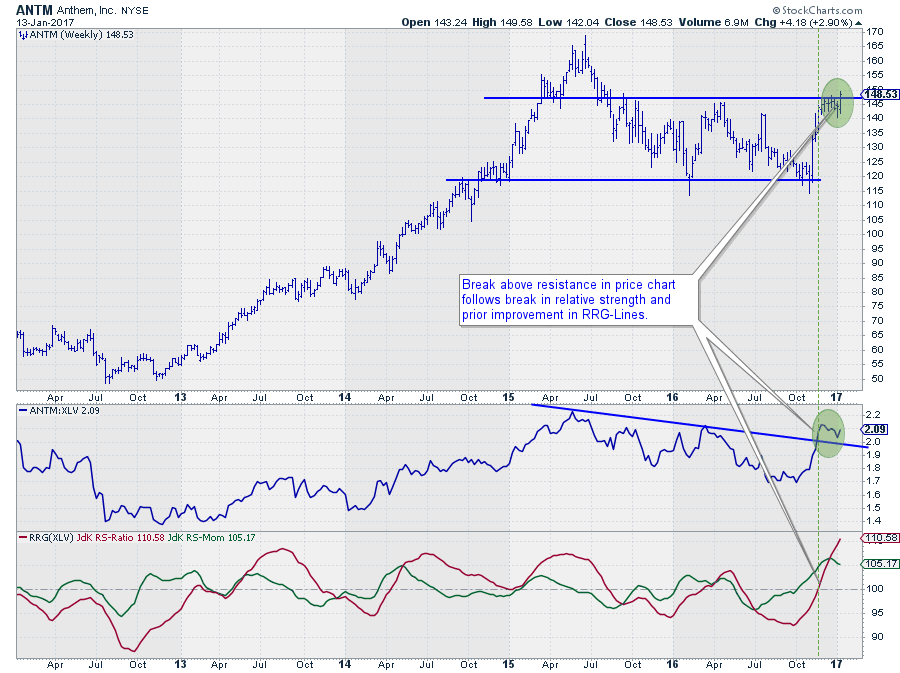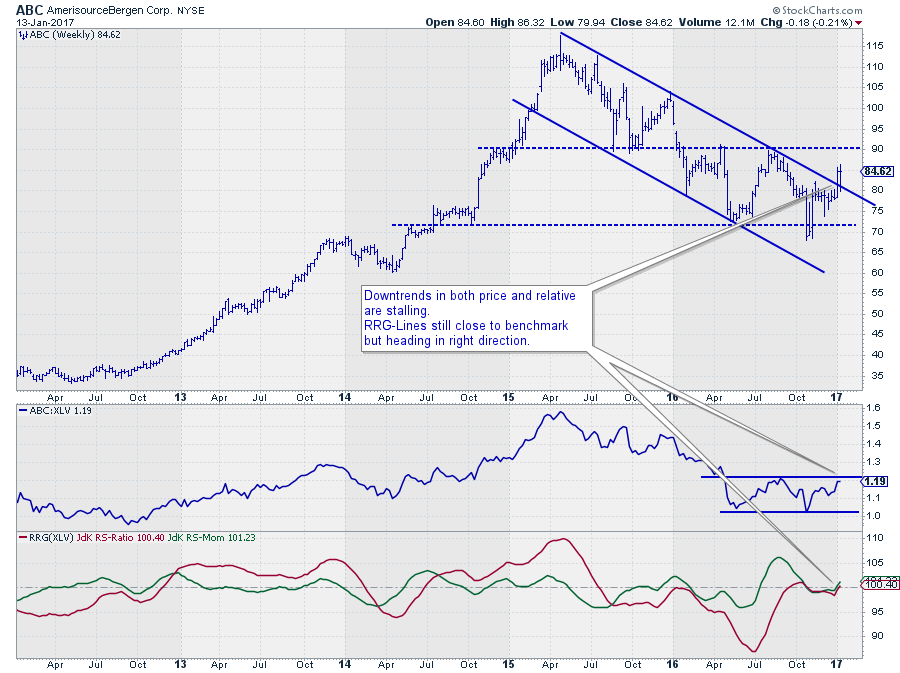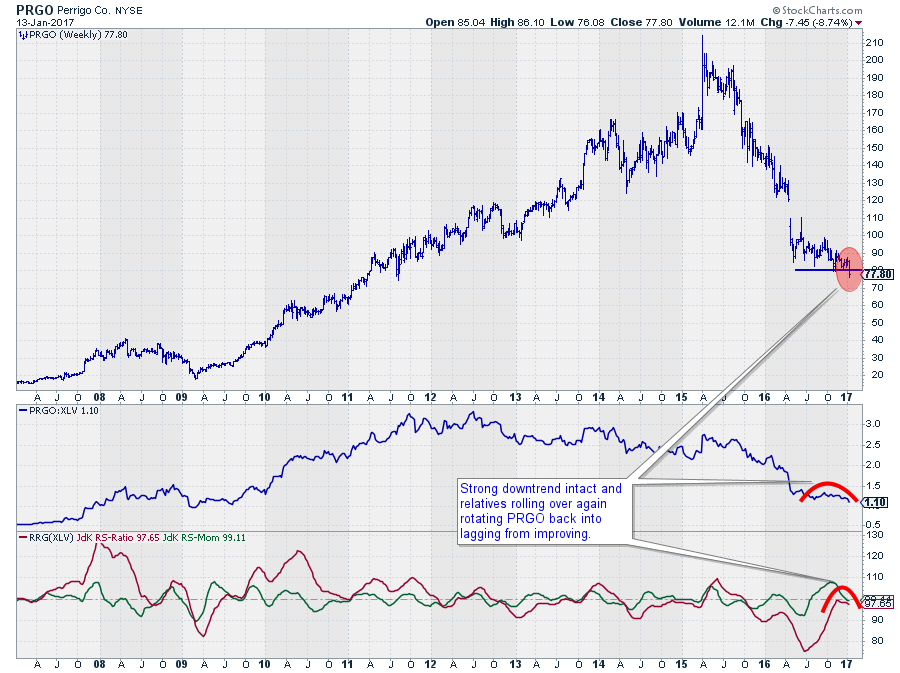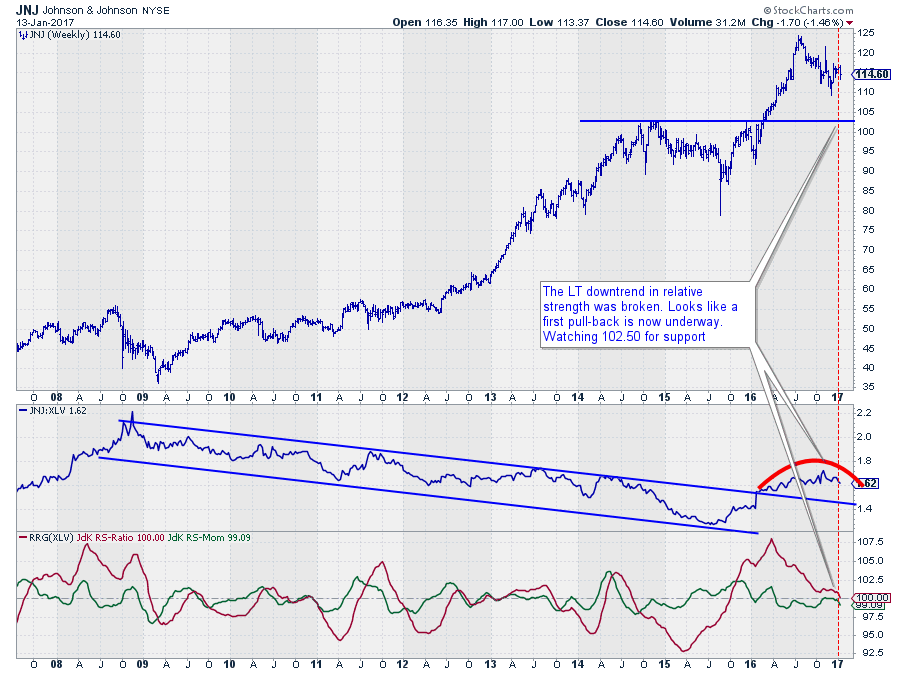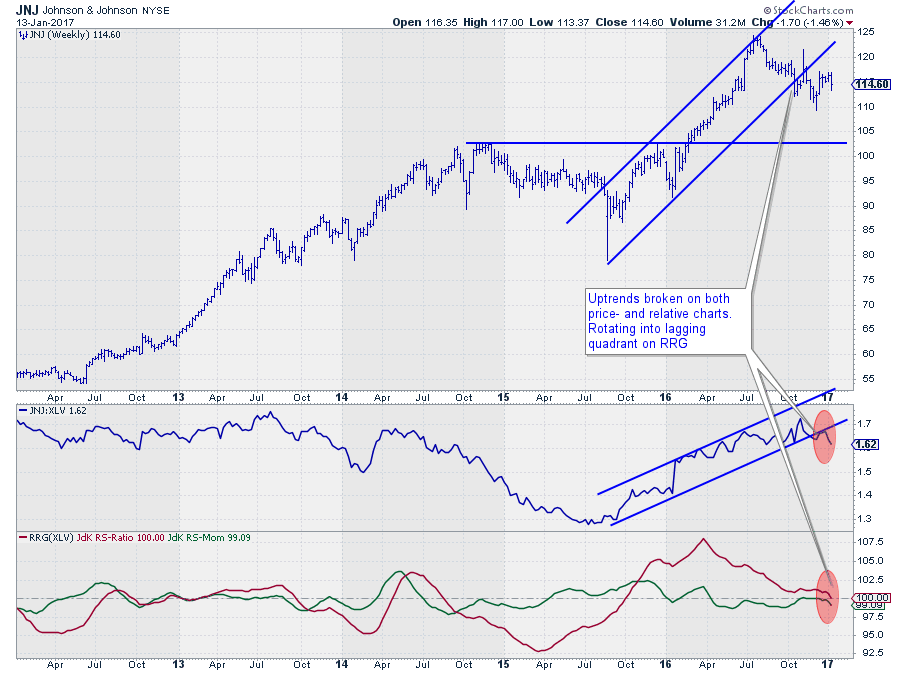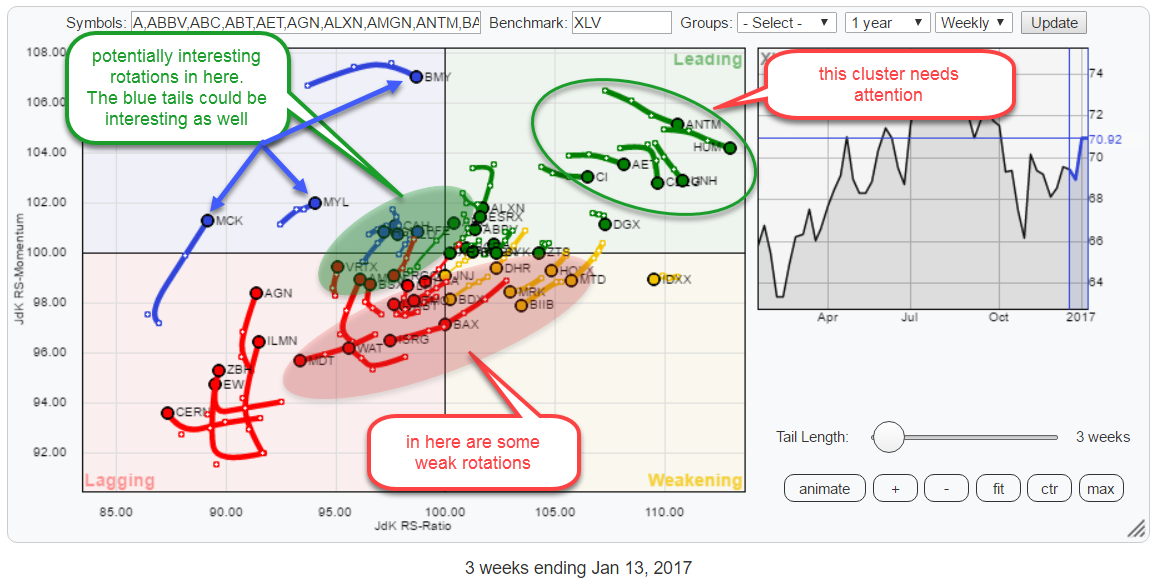 The Relative Rotation Graph above holds the constituents of the XLV (Health Care) ETF. In this post, I want to follow up on my previous article which pointed at the potential rotation from Financials into Health Care and take a look at the relative rotation of individual stocks that make up the sector, against XLV as the benchmark.
The Relative Rotation Graph above holds the constituents of the XLV (Health Care) ETF. In this post, I want to follow up on my previous article which pointed at the potential rotation from Financials into Health Care and take a look at the relative rotation of individual stocks that make up the sector, against XLV as the benchmark.
Over the past week, the relationship improved a little bit for Health Care, but it still is a somewhat "gutsy" view. Not yet a trend that is well underway, so beware.
Summary
- ANTM and HUM in strong relative uptrends against XLV but getting overstretched
- CI stable outperformer in the middel of leading quadrant
- A and ABC offering good potential versus XLV
- Relative trend, price as well, getting even worse for PRGO.
- JNJ is the sneaky pink elephant in the room
(How to) QUICK(ly) SCAN (a crowded RRG)
As you can see on the RRG on top of this article a Relative Rotation Graph holding a lot of securities, in this case the top-50 (based on market cap) names in the Health Care sector, can become very crowded and therefore difficult to read.
There are a few things that you can do to make an RRG more readable when things start to get cluttered.
The first thing that you should always consider is the number of securities to display on one RRG. This has the biggest impact on making an RRG more readable. When looking at the constituents of sectors, we quickly run into higher numbers of securities that we have to deal with.
The Health Care sector as I am looking at in this article holds 60 stocks according to the SPDRS factsheet for XLV. I am keeping a soft maximum of 50 securities for myself, as beyond that; things become really difficult to see. When a sector holds more than 50 constituents, I usually rank the list on weight based on market-cap and use a cut-off at 50.
The second thing that you can do is to shorten the tail length to 3-4 periods to avoid the thing to look like a spaghetti chart.
Finding the best length of the tail for the number of securities on the graph is a bit of a balancing act. You want to make the tail as long as possible but as short as needed (to keep chart readable).
But even then, like in the graph above, it can sometimes be difficult to spot the individual tails and see where they are heading.
One solution is to zoom in and out of various areas of the RRG and take a closer look at the direction and rotation of the individual tails.
Another way of quickly scanning all the tails on the plot is using the highlight functionality in the table below the chart.
When a line in the table below the chart is selected the tail of that security will be highlighted on the graph and the other tails will be dimmed, making the selected security really stand out and the tail well to read. By using the arrow keys you can browse through all securities on the graph.
I always sort the table by the tail color (second column) which makes me browse through the universe from quadrant to quadrant.
The only thing is that while using the down arrow key, the browser will start to scroll down as well, pushing the chart off the screen. For that reason, I first scroll down to the bottom of the list using my mouse, then select the last security. Scroll back up using the mouse to make the chart visible again and then tap the up arrow key to walk through all securities and inspect the individual tails.
The short video below will show you how I do this and indicate which stocks I want to take a closer look at.
Inside the leading quadrant
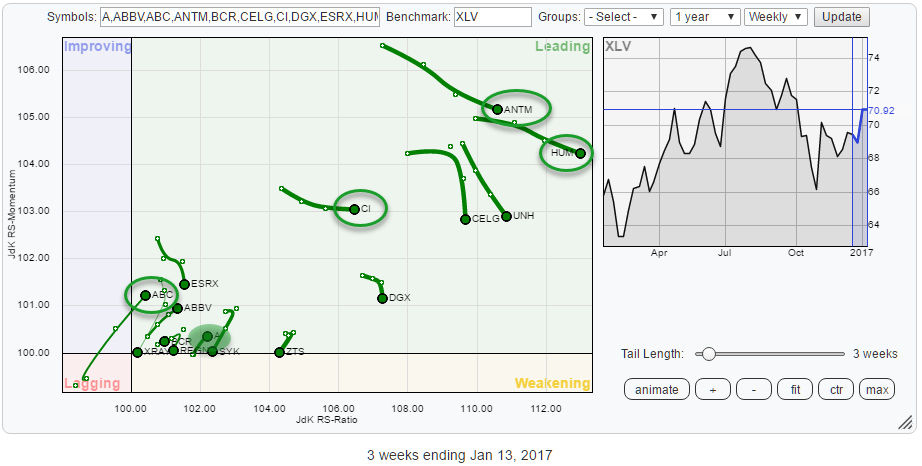 The picture above is a zoomed in (leading quadrant) version of the XLV RRG. A few stocks, like ANTM and HUM, are far to the left at (very) high JdK RS-Ratio levels but starting to lose a bit of relative momentum. They are the strongest stocks in this universe at the moment, but it may not be the best time to jump on board at this point in time.
The picture above is a zoomed in (leading quadrant) version of the XLV RRG. A few stocks, like ANTM and HUM, are far to the left at (very) high JdK RS-Ratio levels but starting to lose a bit of relative momentum. They are the strongest stocks in this universe at the moment, but it may not be the best time to jump on board at this point in time.
Right in the middle is CI with good JdK RS-Momentum and still moving higher on the RS-Ratio scale.
In the cluster closer to the benchmark, I am looking for stocks with a positive heading and circled A and ABC as potentially interesting names.
Strong trend but (temporary) losing relative momentum
Anthem Inc. - ANTM
ANTM recovered rapidly out of its relative lows in the second half of 2016. This relative improvement got support from the price chart when a new low was set against horizontal support in October.
The rally out of this new price low stalled against the top of the trading range at the end of the year but in the early days of 2017 Anthem managed to break higher which opened up the way for a further rally.
The Relative Strength line, meanwhile, has also broken above its falling resistance and the RRG-Lines both pushed above 100, positioning ANTM well inside the leading quadrant.
Given the high reading on the JdK RS-Ratio scale and the loss or relative momentum, I prefer to wait a little longer before jumping on board (again). It is a strong trend but also mature, and chances for a temporary correction are increasing.
Humana Inc. - HUM
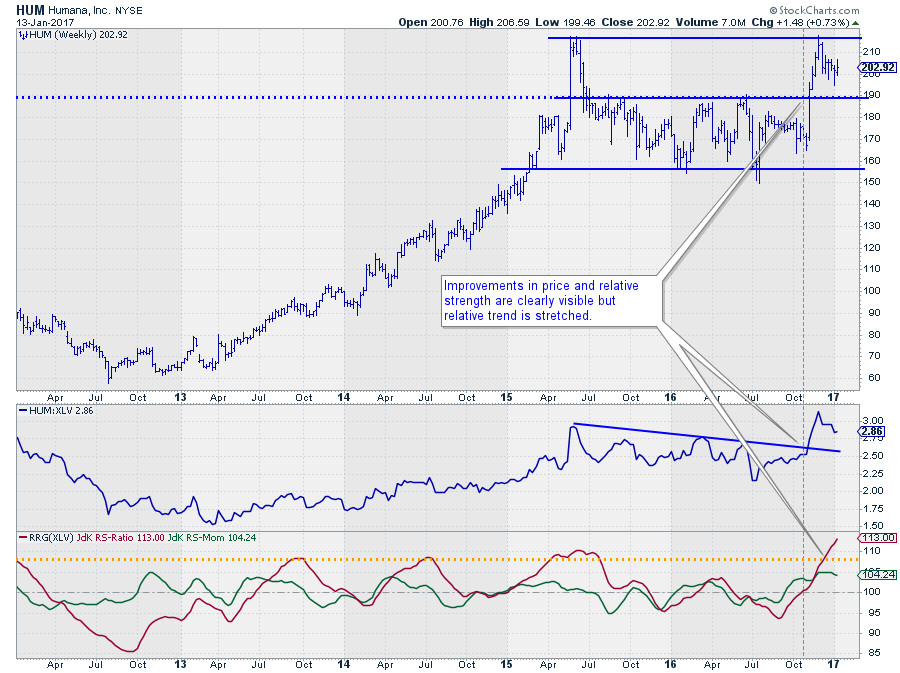 Humana (HUM) is in a similar position as ANTM. Very high reading on the RS-Ratio scale and starting to show a loss of relative momentum.
Humana (HUM) is in a similar position as ANTM. Very high reading on the RS-Ratio scale and starting to show a loss of relative momentum.
No doubt that the relative picture looks fine. Falling resistance was broken in October at the same time as the RS-Ratio line pushed above 100, indicating that a new relative uptrend was starting to get underway.
On the price chart, the trading range is split in half. $ 155 provides support on the downside while $ 215 offers resistance on the top, and has recently been tested.
Around $ 190, some important peaks are lining up in the middle of the range and this level is expected to provide support in case of a (price-)decline in coming weeks.
As the RS-Ratio line has reached historically "high" levels for this universe the conclusion for HUM is similar to the one for ANTM; Strong and mature relative trend but odds for a temporary setback are increasing making an entry at this point in time unattractive.
Still going steady
Cigna Corp - CI
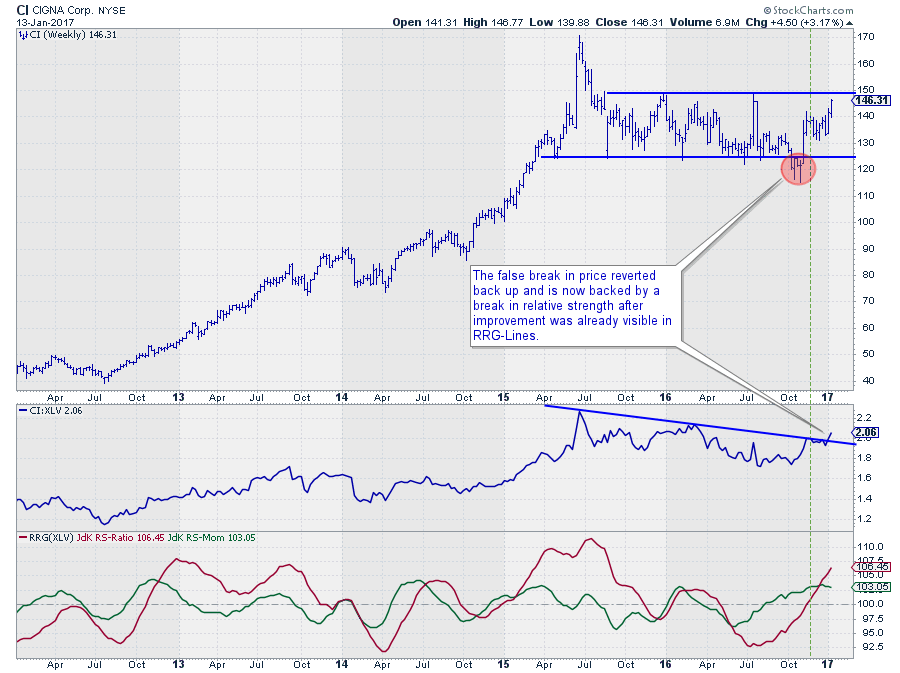 In the middle of the leading quadrant, we find CI moving higher on the JdK RS-Ratio scale at stable momentum.
In the middle of the leading quadrant, we find CI moving higher on the JdK RS-Ratio scale at stable momentum.
The price chart shows an interesting move. In October CI broke below support while RS had started to stabilize and RS-Momentum started to move above 100. Only four weeks after the downward break Cigna broke back above its former support level (now resistance) and immediately rallied strongly. Behavior that often characterizes a false break.
This rally in price certainly helped RS to improve further and pushed CI into the leading quadrant.
From a relative perspective, there is still room to move higher. RS-Ratio has more room to advance before reaching "high" values. The first hurdle that CI needs to deal with is overhead resistance around $ 150. If that barrier can be taken out, the next stop is only found near $ 170, well over 10% from current levels.
Potentially interesting
Agilent Technologies Inc. - A
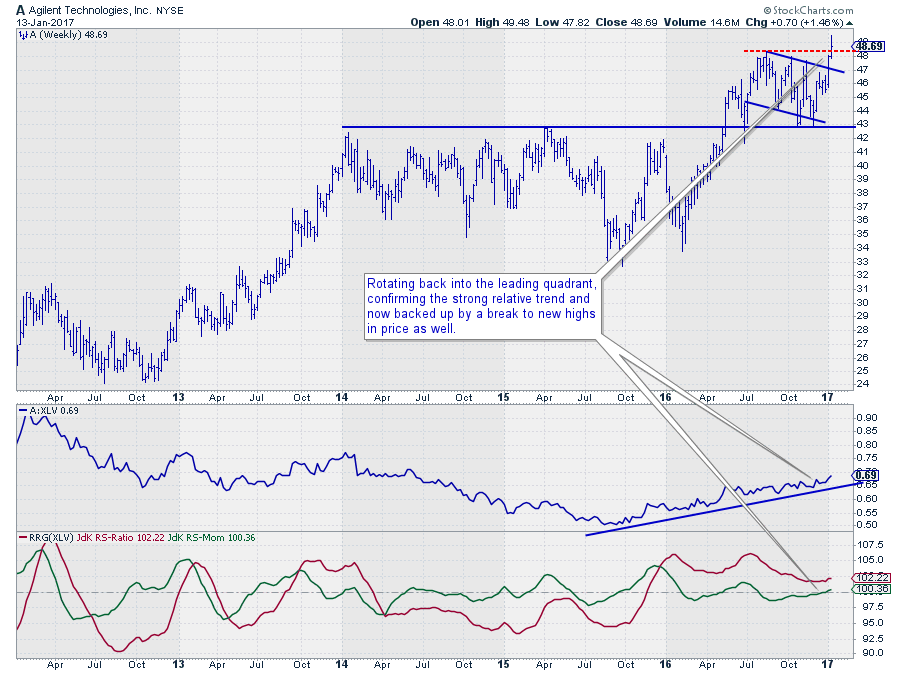 If you open up the live version of the RRG (zoomed in on the leading quadrant) and animate the tail of A by stepping through history, you can see why Agilent Technologies is such an interesting stock at the moment.
If you open up the live version of the RRG (zoomed in on the leading quadrant) and animate the tail of A by stepping through history, you can see why Agilent Technologies is such an interesting stock at the moment.
Over the past months (since September actually) A has been moving through the weakening quadrant showing a very short tail. Just to remind you, short tails indicate stability! It is characteristic for a temporary loss of relative momentum while keeping the longer-term trend intact.
In the first week of 2017 A turned back to a positive heading and crossed over into the leading quadrant again from weakening, something that we know is often a sign of further relative strength in the period following.
The fact that, on the price chart, A has just tested the former resistance area around $ 43 as support and recently left the consolidation pattern while breaking to new highs will certainly help the stock gain relative strength as well.
AmerisourceBergen Corp. - ABC
ABC (AmerisourceBergen) has just left its down trending channel on the price chart and started to work its way higher.
On the RS chart, a trading range has become visible since April/May of last year.
The combination of price and RS- charts has caused the RRG-Lines to move close to the 100-level indicating that not much Alpha was to be expected against XLV.
The recent jump in price has pushed both RRG-Lines upward at the same time and ABC has now rotated into the leading quadrant from improving while its tail is starting to get longer, indicating that there is some power behind the move.
Especially a break above resistance around $ 90 on the price chart will make ABC an interesting stock to watch.
Inside the lagging quadrant
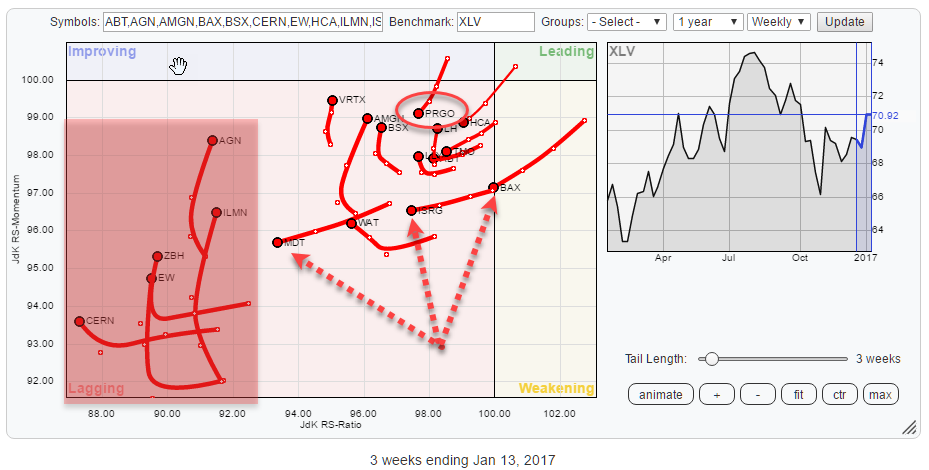 The lagging quadrant shows a lot of stocks that have recently started to move higher on the JdK RS-Momentum scale, especially on the left-hand side of the quadrant. As these stocks are very low on the RS-Ratio scale, meaning that they are in strong and mature relative downtrends, this improvement, for the time being, has to be seen as a temporary rally of relative strength within the longer term downtrend.
The lagging quadrant shows a lot of stocks that have recently started to move higher on the JdK RS-Momentum scale, especially on the left-hand side of the quadrant. As these stocks are very low on the RS-Ratio scale, meaning that they are in strong and mature relative downtrends, this improvement, for the time being, has to be seen as a temporary rally of relative strength within the longer term downtrend.
Stocks like MDT, ISRG and BAX are pushing deeper into the lagging quadrant and are therefore at risk of further underperformance versus XLV.
The one ticker that catches my eye in this area of the chart is PRGO because it is rotating back into the lagging quadrant from improving and has recently started to decline on both axes again.
Perrigo Co. - PRGO
No rocket scientists are needed to conclude that Perrigo is not the strongest chart inside the Health Care sector.
The stalling of the decline in the second half of 2016 caused RS to move somewhat flat and enabled RS-Ratio to recover to almost the 100-level.
But then came January! In the first week of this year, the stock price was hammered down below its fragile support level coming off its recent low.
This confirms that the downtrend is still in full force and expected to pick up speed again. From a relative perspective, there is once again enough room to the downside as all extreme readings from 2016 have been mitigated.
Rotating back into the lagging quadrant, there is nothing to prevent a further underperformance of XLV.
The pink elephant in the room
Johnson & Johnson - JNJ
When looking at the Health Care sector, surely we need to look at Johnson & Johnson. At more than 11% of the market cap for this sector, it is a force that cannot be neglected.
However, at the moment it seems to be the big pink elephant in the room as it was quietly moving near the benchmark, which is normal for heavyweight stocks, but recently (against the improvement of XLV) started to accelerate (tail getting longer) while heading for the lagging quadrant.
So how do we deal with this? Looking at the longer term chart above we can see that the long-term falling channel on the RS-chart was broken at the beginning of 2016. Pretty much all of 2016 the relative strength of JNJ against XLV moved higher but at a steadily declining momentum.
At the moment this loss of relative momentum is now causing the RS-line to roll over, pushing both RRG-Lines below 100 and rotating into the lagging quadrant on the RRG. This means that any relative strength for the sector as a whole will have to come from other stocks in coming weeks.
The good news is that because of the turnaround of the long-term trend in relative strength this setback can very well be seen as the first serious pull-back after the rally started mid-2015.
The former falling resistance line is expected to start acting as support in case of a further decline and the same can be said for the former resistance level near $ 102.50 on the price chart.
With XLV still inside the lagging quadrant and very low on the RS-Ratio scale a turn for the better in JNJ could be the catalyst that is needed to really start pushing XLV towards improving and then leading
The second JNJ chart above is the shorter version showing the recent weakness in more detail. I am watching support around $ 110 and then $ 102.50 for possible turning points. Any lows put into place at those levels in combination with improving relative strength will probably be good entry points.
Julius de Kempenaer | RRG Research
RRG, Relative Rotation Graphs, JdK RS-Ratio and JdK RS-Momentum are registered TradeMarks by RRG Research
Follow RRG Research on social media:

